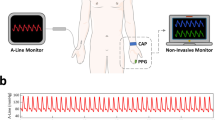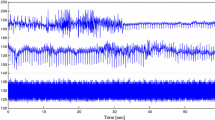Abstract
Existing bedside cardiovascular monitors often inaccurately measure arterial blood pressure during intra-aortic balloon pump (IABP) assist. We have developed an algorithm that correctly identifies features of arterial pressure waveforms in the presence of IABP. The algorithm is adaptive, functions in real-time, and uses information from the electrocardiographic (ECG) and arterial blood pressure signals to extract features and numeric values from the arterial blood pressure waveform. In its current form, it requires reliable ECG beat detection and was not intended to operate under conditions of extremely poor balloon timing. The algorithm was evaluated by an expert (P.F-C.) on a limited data set, which consisted of 12 1-minute epochs of data recorded from 6 intensive care unit patients. A criterion for selection of patients was that the ECG beat detector could detect ECG beats correctly from the waveforms. The overall sensitivity and positive predictivity for beat detection were 94.04% and 100%, respectively. For feature identification, the overall sensitivity was greater than 89%, positive predictivity was 100%, and the false-positive rate was 0%. The performance measures may be biased by the criteria for patient selection. This approach to identifying waveform features during IABP improves the accuracy of measurements. The utility of using 2 sources of information to improve measurement accuracy has been demonstrated and should be applicable to other physiologic signal-processing applications.
Résumé
Les moniteurs cardiovasculaires actuels ne permettent souvent qu’une mesure imprécise de la pression artérielle lors de l’ assistance circulatoire realisee par une contre-pulsion par ballonnet intra-aortique (CPBIA). Nous avons développé une algorithme qui identifie correctement les caractéristiques du signal de pression arterielle en présence d’une CPBIA. L’algoritme est adaptatif, fonctionne en temps reel et utilise l’information en provenance du signal electrocardiographique (ECG) et du signal de pression artérielle pour extraire caractéristiques et valeurs numériques du signal de pression artérielle. Dans la forme usuelle, il nécessite une détection ECG fiable de la systole et ne peut être opérationnel dans des conditions de trés faible synchronisation d’inflation du ballonnet. L’algorithme a été évalué par un expert (P.F.C.) sur un ensemble limité de donnees, constitue par l’enregistrement de 12 périodes de 1 minute chez 6 patients d’unités de soins intensifs cardiologiques. Un critere de selection des patients était que le détecteur ECG de systole puisse détecter correctement les systoles. La sensibilité et la valeur prédictive positive de la detection d’une systole ont été respectivement de 94,04 % et 100 %. En ce qui concerne l’identification des caracteristiques, la sensibilité a été supérieure á 89 %, la valeur prédictive positive a été de 100 % et le pourcentage de faux positifs a été de 0 %. Les mesures de performance peuvent être biaisées en raison du critére de sélection des patients. Cette approche en vue d’identifier les caractéristiques du signal de pression artérielle lors d’une assistance circulatoire par CPBIA améliore la précision des mesures. L’utilisation de 2 sources d’information pour ameliorer la precision des mesures a été démontrée et pourrait s’dappliquer aux méthodes de traitement du signal d’autres paramétres physiologiques.
Kurzfassung
Der arterielle Blutdruck wird während der Ballonpumpen-Unterstützung in der Aorta (IABP) von den derzeitigen kardiovaskulären Überwachungsgeräten am Krankenbett oft nur ungenau gemessen. Wir haben einen Algorithmus entwickelt, der die Kennzeichen der Wellenformen des arteriellen Drucks bei IABP richtig identifiziert. Der Algorithmus ist adaptiv, arbeitet in Echtzeit und verwendet Signale des Elektrokardiogramms (EKG) und des arteriellen Blutdrucks, um aus der Wellenform des arteriellen Blutdrucks Merkmale und Zahlenwerte zu gewinnen. In seiner gegenwärtigen Form erfordert er zuverlässige EKG-Schlagerkennung und war nicht dazu bestimmt, bei außerordentlich schlechtem Ballontiming zu arbeiten. Der Algorithmus wurde von einem Experten (P.F.C.) anhand eines begrenzten Datensatzes beurteilt, der aus 12 einminütigen Datenreihen von 6 Intensiv-Patienten, bestand. Ein Kriterium für die Patientenwahl war, daß der EKG-Schlagdetektor die EKG-Schläge richtig aus den Wellenformen ermitteln konnte. Die Gesamtempfindlichkeit und die positive Vorhersagbarkeit der Schlagerkennung betrugen 94,09 % bzw. 100%. Bei der Merkmalerkennung war die Gesamtempfindlichkeit größer 89%, die positive Vorhersagbarkeit betrug 100% und die Falsch-Positiv-Rate 0%. Der Leistungsgrad kann durch die Kriterien fur die Patientenwahl beeinflußt sein. Der Ansatz, die Merkmale der Wellenformen bei IABP zu identifizieren, verbessert die Meßgenauigkeit. Die Zweckmäßigkeit, zwei Informationsquellen zur Verbesserung der Meßgenauigkeit zu verwenden, wurde dargelegt und sollte für andere Anwendungen der physiologischen Signalverarbeitung geeignet sein.
Resumen
La medición de presión arterial mediante los monitores cardiovasculares actualmente disponibles es a menudo inadecuada durante asistencia circulatoria con balón de contrapulsación intraaórtica (BCIA). Hemos desarrollado un algoritmo que identifica correctamente las características de la onda de presión arterial durante BCIA. El algoritmo es adaptivo, funciona en tiempo real, y usa información de las señales de electrocardiograma (ECG) y presión arterial para extraer las características y valores numéricos desde la onda de presion arterial. En su forma actual, requiere buena detección de la onda R del ECG y no está diseñado para funcionar si la sincronización del BCIA es inadecuada. El algoritmo fue evaluado por un experto (P.F.C.) usando un conjunto limitado de datos que consistía en 12 períodos de información de un minuto cada uno, obtenidas en 6 pacientes de intensivo. Un criterio de selection de los pacientes fue que el detector de onda R del ECG pudiese detectar latidos cardíacos correctamente a partir de las ondas. La sensibilidad global y la predictividad positiva para detección de latido fue 94,04 % y 100%, respectivamente. Para identification de características, la sensibilidad global fue mayor de 89%, la predictividad positiva 100%, y los falsos positivos 0%. Las mediciones pueden haber estado sesgadas por el criterio de selection de pacientes. Esta tecnica de identificatión de las características de la onda de presión durante BCIA mejora la precisión de las mediciones. La utilidad de usar 2 fuentes de información para mejorar la precisión de las mediciones ha sido así demostrada y deberiá ser aplicable a otras aplicaciones de procesamiento de señales fisiológicas.
Similar content being viewed by others
Reference
Ohley WJ. Counterpulsation: theory and practice. IEEE Eng Med Biol Mag 1986; 1: 14–18
Health Devices: Intra-aortic balloon pumps. Health Devices 1981; 11: 3–38
Buckley MJ, Leinbach RC, Kastor JA, Laird JD, Kantrowitz AR, Madras PN, Sanders CA, Austen WG. Hemodynamic evaluation of intra-aortic balloon pumping in man. Circulation 1970; 41: 130–136 (suppl II)
Niederer P, Schilt W. Experimental and theoretical modeling of intra aortic balloon pump operation. Med Biol Eng Comput 1988; 26: 167–174
Health Devices: Intra-aortic balloon pumps. Health Devices 1987; 16: 135–180
Ford PJ, Weintraub RM. Intra-aortic balloon pumping manual. Cambridge: Aristocrat Press, 1974
Welch J, Martin P, Ford P, Herrig N. A comparison of algorithm performance. Proceedings of the 21st Annual Meeting of the Association for the Advancement of Medical Instrumentation 1986: 80
Health Devices Alerts: Inaccurate blood pressure readings on IABP patients. Health Devices 1989; 18: 138–139
Ladin Z, Trautman E, Teplick R. Contribution of measurement system artifact to systolic spikes. Med Instr 1983; 17: 110–112
Price SA, Wilson LM. Pathophysiology clinical concepts of disease processes, 3rd ed. New York: McGraw-Hill, 1982: 329–453
Braunwald E: Heart disease, 3rd ed. Philadelphia: Saunders, 1988
Bolooki H: Special topic: instrumentation in cardiology. Med Instr 1985; 20: 266–276
Ford P, Teplick R, Welch J, Martin P, Newbower R. The MGH hemodynamic and electrocardiographic database: a collection of critical care tracings. Proceedings of the 21st Annual Meeting of the Association for the Advancement of Medical Instrumentation 1986: 26
Siemens Medical Electronics: Operating instructions-system Sirecust (1280/1281). Danvers, MA: Siemens Medical Electronics, 1987: 51
Nellcor: Nellcor N-200 pulse oximeter operation manual. Nellcor Inc., Hayward, CA, 1987: 11
Navabi MJ, Watt RC, Hameroff SR, Mylrea KC. Integrated monitoring can detect critical events and improve alarm accuracy. J Clin Eng 1991; 16: 295–307
Hewlett ackard: An algorithm for reduction of respiration artifact in pulmonary artery pressure measurement, Hewlett Packard, Waltham, MA, 1983
Author information
Authors and Affiliations
Rights and permissions
About this article
Cite this article
Elghazzawi, Z.F., Welch, J.P., Ladin, Z. et al. Algorithm to identify components of arterial blood pressure signals during use of an intra-aortic balloon pump. J Clin Monitor Comput 9, 297–308 (1993). https://doi.org/10.1007/BF02886704
Received:
Issue Date:
DOI: https://doi.org/10.1007/BF02886704




